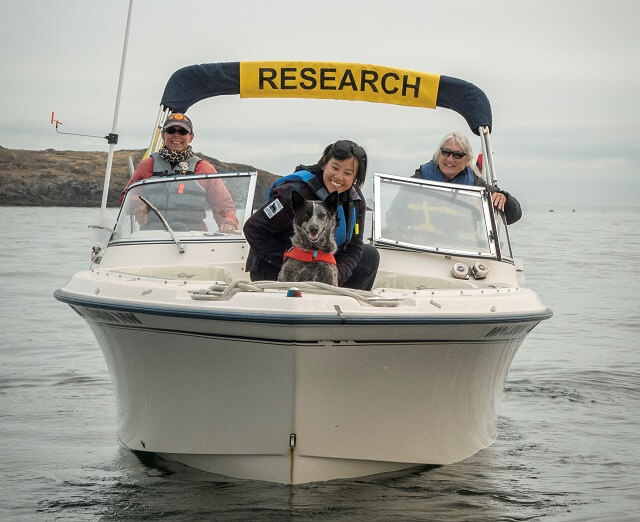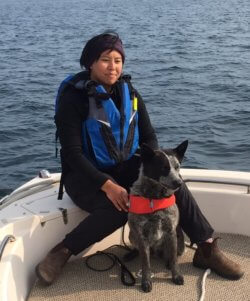
Dio with Deborah Giles (left), Collette Yee and Sharon Grace. Photo: Katy Foster/NOAA Fisheries, under permit 18786.
Meet Dio, canine member of the team that’s working to help the ailing orca Scarlet (J-50).
Dio is an ace sniffer dog, and his role is to direct the research vessel to where his colleagues can gather a sample of whale scat and take it back to the lab.
Researchers can glean amazing amounts of information from whale poop (what scientists call “fecal data”) – like what they’re eating, reproductive status, stress level, environmental toxin levels – about the health of an individual animal and of the pod overall. And to get a good diagnosis of what’s ailing Scarlet and what medication she might best respond to, they need a good sample of her droppings.
But first they need to locate a fresh sample. And that’s Dio’s job. He’s everything you want in a sniffer dog and everything that a lot of people don’t want in a family pet: a dog who’s high-energy and obsessed with chasing after balls.
Dogs like Dio often end up at a shelter, and it can be hard to place a rambunctious, ball-obsessed dog in a family home. In Dio’s case, he was a young, stray Queensland heeler mix with an injury to his jaw, who was picked up and brought to the Humboldt County Animal Shelter in northern California. The shelter staff despaired of being able to find him a home because of his off-the-wall high energy. But a volunteer realized that he would be a great sniffer dog, and in August 2015 he found himself on his way north to the University of Washington’s Center for Conservation Biology, where he joined the Conservation Canines Division.
Dio can detect odors so faint they’re just three parts in a million.Dio is one of 17 dogs, eight handlers and five lab staff at Conservation Canines, who can be working on anything from tracking down herds of caribou, to establishing the range of a pocket mouse or a barred owl, to Dio’s current assignment locating whale scat.
Their talent is unmatched. Dio can detect odors so faint they’re just three parts in a million. He can hone in on a sample of whale scat from more than a nautical mile away, even in fast-moving currents. Conservation Canines founder, biologist Sam Wasser, compares the dogs’ ability to detect a specific scent to you or me being able to taste a teaspoon of sugar in a million gallons of water.
Wasser has been called the Sherlock Holmes of the wildlife trade. A conservation biologist, professor and research scientist, he pioneered the genetic, endocrine and detection dog techniques that are used by the Center for everything from tracking down the origins of elephant ivory seized by international law enforcement to the kind of work that Dio is doing to help the Southern Resident orcas.

Dio with Collette Yee. Photo: Whale Sanctuary Project/NOAA Fisheries, under permit 18786.
One day last week, Dio was aboard NOAA’s research vessel with his handler, Colleen Yee, along with Sharon Grace of the Southern Resident Killer Whale Chinook Salmon Initiative, and Dr. Deborah Giles of Wild Orca. Giles (she goes by her last name) is a resident scientist and lecturer at the University of Washington’s Friday Harbor Labs, and the vessel captain for the Center for Conservation Biology.
With Giles directing the overall operation, Dio was on the bow of the boat with Yee holding his leash. To locate a sample of scat, the boat moves perpendicular to the wind up to a quarter of a mile behind or parallel to the whales depending on the direction of the wind. This helps Dio pick up the scent, and he alerts Yee by pulling over to one side of the boat to show her where to direct the boat. The team then follows the changes in his behavior until they arrive at the sample.
Each sample collected is extracted and assayed for DNA stress, reproductive and nutrition hormones, as well as toxicants (PCB, PBDE and DDT congeners). Usually, this kind of work observes the whales over time, but on this mission Giles and her team were looking for specific information about one whale, Scarlet, and that’s a lot trickier since she needs to be sure she’s getting a sample from her and only her. Still, the researchers collected several fecal samples, and Giles said they’ll be able to conduct genetic typing to discover which whale left which sample, and will be able to test for stress or pregnancy hormones as well as for nutrition information.
If the team determines they need another sample, Dio will get another day on the ocean. If not, he’ll be back on land again for a while, tracking down more treasures from the other kinds of animals who are his specialties: wolverines, bats and various birds.
For the researchers, it’s critically important conservation work. For Dio and his pals, it’s just another day spent doing his favorite thing.
4 Comments
Love this blast from the past article about Dio. Dio is now working for a brand new conservation detection dog program, Rogue Detection Teams, continuing his mission to sniff for endangered wildlife, one scat at a time. You can check them out at http://www.roguedogs.org.
Wow Dio is amazing. A miracle worker for conservation.
Dogs never cease to amaze me with their ability to be super heroes!!
Go Dio!